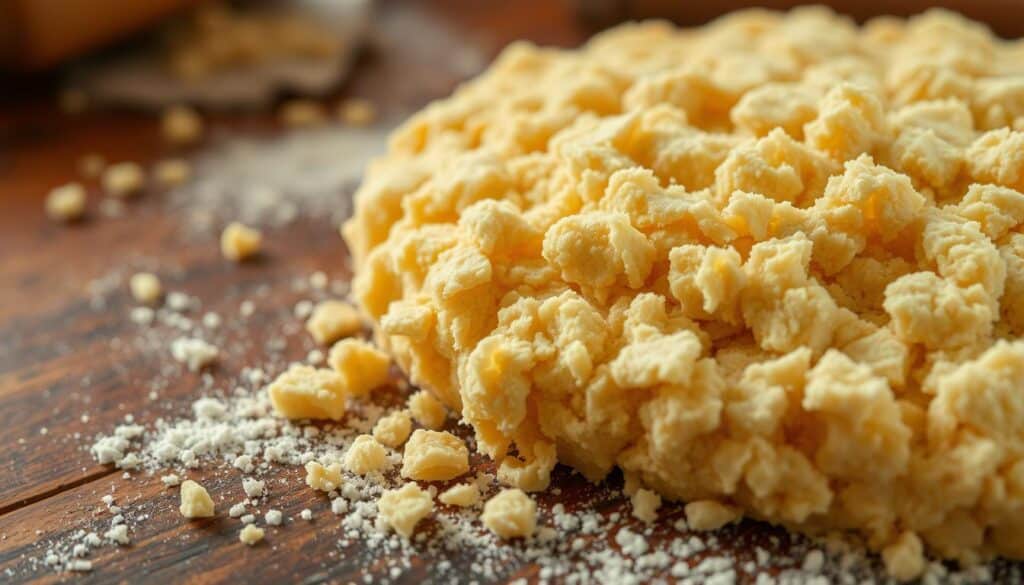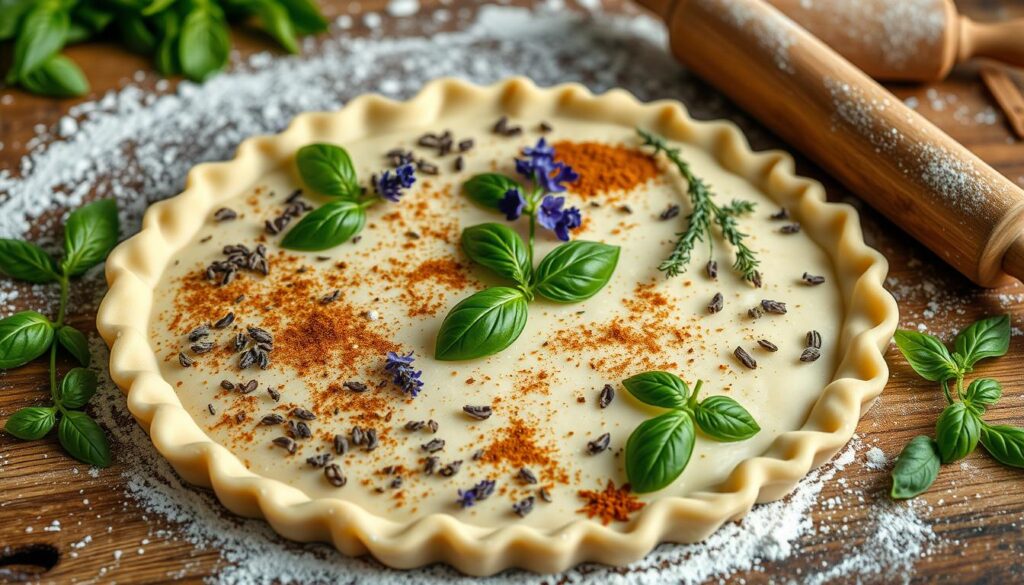Picture this: biting into a pie slice and encountering a symphony of textures. The star is a buttery flaky crust that enhances the tasty filling. Getting your homemade pie crust right can elevate your baking from normal to amazing. Whether it’s your first time with dough or you’re an expert baker, this guide is your secret to mastering pie crusts.
Many bakers aim to perfect their pie crust recipe. It’s all about the buttery layers and tender base. Learn the secrets to making a homemade crust that’s more than just good—it’s great. With our tips, your pies will reach new heights of quality, making everyone want to know how you did it. So, get ready to mix, chill, and roll your way to a perfect crust!
Key Takeaways
- Discover the pivotal role of cold ingredients in achieving a flaky pie crust.
- Understand the importance of proper handling techniques to avoid a tough pastry.
- Learn how to make pie crusts that are versatile for both sweet and savory recipes.
- Find out the best way to store and freeze your pie dough for future use.
- Gain the confidence to create a buttery, homemade pie crust that rivals any bakery.
Why a Perfect Pie Crust Is Essential for Every Baker
The foundation of desserts isn’t just about the sweetness or toppings. It begins with something you might overlook—the pie crust. Mastering a perfect pie crust shows real baking artistry. It turns basic ingredients into bases that make both savory and sweet pies stand out. This skill lifts bakers from beginners to experts, showcasing their work’s flavor and look.
For savory pies, the crust grabs your first impressions of sight and touch. It’s as crucial as the pie’s inside. A flaky, golden crust adds an unmatched texture and taste that complements the filling. It makes dishes, from a classic chicken pie to innovative ones like those in chicken cutlet recipes, really shine.
Learning this skill opens the door to numerous savory pies and baking techniques. It allows bakers to try different crust shapes for various needs and events. This shows that a pie crust is indeed the foundation of desserts.
To truly be an expert, knowing all about different crust types is key. Each kind, from buttery to crunchy, has its own role in both sweet and savory dishes. Being versatile in making crusts is a must-have quality for any baker.
Choosing the Right Ingredients for Your Pie Crust
The key to a perfectly flaky pie pastry lies in your ingredients’ quality. Getting the right mix of fats, flour, and seasonings is essential. It’s how bakers create textures and flavors people love.
Importance of Using Cold Butter and Shortening
Cold unsalted butter is vital for a flaky and tender crust. Keeping butter cold prevents it from melting too soon when baked. This creates those airy layers everyone admires.
Vegetable shortening has a higher melting point than butter. It helps keep the pie crust’s shape, perfect for detailed designs. Using both fats enhances pie pastry’s taste and feel.
The Role of Flour and Salt in Pie Dough
All-purpose flour is the top pick for pie crusts. It balances softness and strength. Kosher salt does more than just add flavor. It makes the dough strong and elastic. These ingredients set the stage for amazing pies.

| Ingredient | Role in Pie Crust | Ideal Temperature |
|---|---|---|
| Cold unsalted butter | Provides flakiness through layered fat | Keep refrigerated until use |
| Vegetable shortening | Ensures structural integrity and ease of handling | Ambient or slightly chilled |
| All-purpose flour | Forms the base structure of the crust | Room temperature |
| Kosher salt | Enhances flavor and dough strength | Room temperature |
Step-by-Step Guide: How to Make Pie Crust Recipe
Starting your baking journey begins with this easy pie crust recipe. Mastering pie making boosts your cooking abilities. It also gives you a feeling of success.
Start by mixing your dry ingredients. Carefully combine ingredients like flour and salt for the perfect base. This step is key for your dough’s texture.
Add cold, cubed butter to the flour next. Use a pastry cutter for blending until it looks like coarse crumbs. This method is inspired by the famous pie crust preppy kitchen. They’re known for great texture and taste.
Slowly add ice water, stirring until the dough clumps. Aim to form into ball gently; don’t overwork it. Too much handling makes the crust tough.
Split the dough into pieces, shape into discs, and use plastic wrap to cover them. Chill for at least an hour. This step helps make the crust flaky.
| Ingredient | Quantity | Role in Dough |
|---|---|---|
| Flour | 2 1/2 cups | Provides structure |
| Salt | 1 tsp | Enhances flavor |
| Butter, cold | 1 cup | Creates flakiness |
| Ice Water | 4 to 8 tbsp | Binds the dough |
This easy pie crust recipe doesn’t just improve your baking skills. It also lets you play with different fillings. A perfect crust is the start of a perfect pie, sweet or savory!
The Secret to Mixing: Cutting Fats into Flour
Starting with cut fats into flour is key for a perfect pie crust. This basic step is crucial in baking. It affects the crust’s texture and flakiness. Whether making a savory quiche or a sweet apple pie, blending fat and flour correctly is fundamental. It’s the cornerstone of the famous Pioneer woman never fail pie crust.
Crafting the Perfect Crumbly Texture
To get tender crust layers, mixing fats like butter with flour is essential. Don’t fully blend them. Instead, aim for small, pea-size crumbs. This gives crust its flakiness because fat particles melt when baked, creating air pockets.

Tools of the Trade: Using a Pastry Blender or Forks
Using your hands to mix might melt the fat too early, affecting flakiness. So, a pastry blender is best for mixing without warming the fat. It keeps dough ideal. No pastry blender? Two forks can work too, but it’s harder and takes more time.
Cutting fats into flour right is rewarding. It’s amazing how simple steps lead to delicious, flaky crust layers. When made using the Pioneer woman never fail pie crust method, it’s irresistible.
Rolling and Shaping: Techniques for a Flawless Pie Base
Getting your pie base right starts with rolling and shaping your dough well. You’ll need a rolling pin and parchment paper for this. These help you get your crust just thin enough and fit it into your pie pan without tearing.
To make your uniform pie crust really stand out, follow our detailed steps. They make the process easier and improve your crust’s texture and firmness.
How to Achieve a Uniform Thickness
Keep your pressure steady when you use your rolling pin. You want your pie dough to be the same thickness all over. Start in the middle and roll outward, turning the dough a bit each time.
This stops parts of the crust from getting too thick or too thin, which can cause baking problems. To keep the dough from sticking, use parchment paper above and below it. This trick stops stickiness without needing too much flour.
Transferring the Dough Without Cracking
Moving your dough to the pie pan can be hard. It sometimes sticks or splits. To avoid this, wrap the dough around your rolling pin, then unroll it over your pan.
This technique keeps the dough from breaking and lets you place it perfectly in the pan. After positioning, lightly press the dough into the pan’s bottom and sides. Trim any extra dough off. For top pie crust tips, check out Zoe Bakes and Mami Recipes.
Creative Variations: Flavoring Your Pie Crust
Mixing the art of baking with flavor science creates magic. Adding unique flavors to your pie crust turns a plain dessert into something special. Imagine a pumpkin pie recipe with a crust infused with gingersnap, or a cinnamon-spiced crust for your apple pie recipe pie crust.
There are many flavor choices, all adaptable to the seasons and your taste. Your pie crust can go from overlooked to the star of your dessert with just a hint or a strong infusion.

- Vanilla bean paste for a sweet, aromatic base.
- Zest of lemon or orange for a citrusy kick, ideal for summer pies.
- Lavender or rosemary, finely chopped, for a floral touch in a savory dish.
This creative touch not only makes your pies stand out but also enhances the dining experience. For tips and ideas on making a perfect flaky pie crust, check out this guide.
| Ingredient | Flavor Profile | Ideal Pie Filling Pairing |
|---|---|---|
| Cinnamon | Warm and spicy | Apple pie, sweet potato pie |
| Nutmeg | Slightly sweet and nutty | Pumpkin pie, custard pie |
| Cardamom | Intense and aromatic | Peach pie, pear tart |
Picking the right flavors means each pie bite blends perfectly with the filling’s taste, leaving an unforgettable impression on your guests.
Tips for Pre-Baking or ‘Blind Baking’ Pie Crust
Learning how to blind bake is key for great pie crusts. This step is needed for pies that need a cooked crust first. Like for a quiche or lemon meringue pie. Blind baking keeps the crust from getting soggy. It ensures the crust keeps its shape and supports your tasty fillings well.
To start blind baking, you’ll need pie weights. You can use common kitchen stuff. Like dry beans or rice, instead of buying special pie weights. These help press the dough down in the pan. They stop the bottom from bubbling up or the sides from falling over while it bakes.
Why Pie Weights are Essential
Pie weights are really important for blind baking. Without them, the dough can puff up because of air pockets. This happens when it’s heated. Using things like dry beans or rice keeps the crust flat. It helps cook it evenly and smoothly.
How to Prevent Shrinking and Soggy Bottoms
To stop your crust from shrinking, chill it well before you start. This makes the fat firm and reduces shrinking. Also, prick the bottom with a fork to let steam out. After baking with pie weights for 15 to 20 minutes, take them out. Keep baking until the crust is golden and crisp. Then, it’ll be ready for any filling without being soggy.
For more tips on making the perfect pie crust, check out these awesome pie-making tips. You’ll learn bakery secrets that can make your pies almost professional.
Freezing and Storing Pie Dough for Future Creations
Getting your pie dough ready ahead of time changes everything for bakers. Follow the right freezing instructions to keep your dough fresh. This works whether you’re making something savory or a sweet puff pastry recipe. Make sure to wrap the dough well before putting it into a freezer ziplock bag. This protects it from getting freezer burn and taking on other smells.
Best Practices for Freezing Unbaked and Baked Pie Crust
Storing your pie dough correctly means you’ll always be ready to bake. Wrap unbaked dough in plastic wrap, then into a freezer ziplock bag. This keeps it sealed tight. The same goes for baked pie crusts to keep them fresh. Remember to mark your bags with the freezing date for better organization.
Thawing Tips for Perfect Results
To use your dough, thaw in refrigerator overnight. Thawing it slowly stops it from getting soggy, giving you that ideal crust. Be sure to use it quickly after thawing for the best taste and texture.
With these tips for freezing and storing, you can be more efficient in the kitchen. You’ll still get to enjoy the flavor and feel of fresh pie crusts. Saving time and improving your baking is what it’s all about.
Conclusion
Making the best pie crust is like creating any top-notch homemade dessert. It’s about care, precision, and putting your heart into it. As we’ve learned, little things matter a lot in baking. The way you blend butter, and roll the dough, makes a huge difference.
A homemade pie brings comfort and joyful memories. It’s loved by so many for its flaky layers and inviting smell. Each ingredient has a special role. Knowing how to mix them right leads to a dessert that wins hearts. A perfect blend of fats with flour makes it flaky. The right rolling makes the base crisp and even.
On our baking journey, remember every step matters, from mixing to shaping. Tips, like how to add flavors or store your pie, guide you to dessert perfection. Get ready to make pies that stand out. They will taste as good as they look, bringing the warmth of homemade treats to everyone. By following this guide, your pies will become known for their excellence.
FAQ
What are the essential ingredients for a perfect pie crust recipe?
You’ll need cold unsalted butter, vegetable shortening, all-purpose flour, and kosher salt for a perfect pie crust. These ingredients make a pastry that’s buttery, flaky, and tender.
How can cold butter and shortening improve my pie crust?
Cold butter and shortening are key for flaky pie crusts. They create steam pockets as the crust bakes. This makes the crust flaky.
Why is all-purpose flour recommended for pie dough?
All-purpose flour is great as it’s neither too heavy nor too light. It gives pie crusts the right balance of tenderness and strength.
Can you briefly explain the process to make a homemade pie crust?
Start by mixing flour and salt. Then, cut in cold fats till crumbly. Slowly add water until it holds together. Form into a ball and chill it. Then, roll it out before use.
How do I create a crumbly texture in my pie dough?
Get a crumbly texture by cutting cold fats into the flour. Use a pastry blender or two forks. You want it to look like coarse crumbs for the best layers.
Which tools help with mixing the fats into the flour?
A pastry blender mixes fats and flour well. If not available, forks or quickly used fingers work to get that crumbly texture.
What are the keys to rolling and shaping a flawless pie crust?
Use a rolling pin and parchment paper for an even thickness. Turn the dough often to keep it from sticking.
To transfer the dough, wrap it around your rolling pin, then unroll it onto the pan smoothly.
How do I prevent my pie crust from cracking when I transfer it to the pan?
Make sure the dough is chilled before moving it. Roll it around a rolling pin and gently lay it in the pan. Press together any cracks lightly.
How can I add unique flavors to my pie crust?
Try using flavored liquids instead of water, or add zest and spices to the flour. You can also mix in ground nuts or cheese that goes well with your filling for extra flavor.
What is blind baking, and why is it necessary?
Blind baking pre-bakes the crust before adding the filling. It’s needed for wet fillings or when the filling cooks faster than the crust, ensuring the bottom cooks fully and isn’t soggy.
Why are pie weights essential for blind baking?
Pie weights stop the crust from puffing up or shrinking while blind baking. This helps the crust keep its shape and bake evenly.
How do I properly freeze and store pie dough?
Wrap the dough tightly in plastic, then in a ziplock bag. For pre-shaped crusts, freeze in the pan first. Always label and date them for storage.
Are there any special tips for thawing frozen pie dough?
Thaw it in the fridge overnight. Or, let it sit at room temperature until pliable but cold. Don’t use the microwave, as it can cook the dough unevenly.
Source Links
- https://tastesbetterfromscratch.com/perfect-pie-crust/ – Perfect Pie Crust Recipe – Tastes Better From Scratch
- https://sallysbakingaddiction.com/baking-basics-homemade-buttery-flaky-pie-crust/ – Homemade Pie Crust Recipe & Video – Sally’s Baking Addiction
- https://www.allrecipes.com/recipe/12492/pie-crust-iv/ – Best Pie Crust



